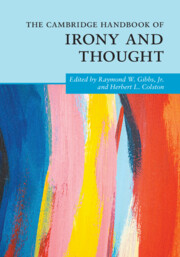Book contents
- The Cambridge Handbook of Irony and Thought
- Cambridge Handbooks in Psychology
- The Cambridge Handbook of Irony and Thought
- Copyright page
- Contents
- Contributors
- Part I Introduction
- Part II The Scope of Irony
- Part III Irony’s Impact
- Part IV Irony in Linguistic Communication
- 8 Constructions in Verbal Irony Production: The Case of Rhetorical Questions
- 9 Tracking the Ironical Eye: Eye Tracking Studies on Irony and Sarcasm
- 10 Inferring Irony Online
- 11 Irony and Thought: Developmental Insights
- 12 Vocal Strategies in Verbal Irony
- 13 Great Expectations and EPIC Fails: A Computational Perspective on Irony and Sarcasm
- Part V Irony, Affect, and Related Figures
- Part VI Irony in Expressive, Nonlinguistic Media
- Index
- References
12 - Vocal Strategies in Verbal Irony
from Part IV - Irony in Linguistic Communication
Published online by Cambridge University Press: 20 December 2023
- The Cambridge Handbook of Irony and Thought
- Cambridge Handbooks in Psychology
- The Cambridge Handbook of Irony and Thought
- Copyright page
- Contents
- Contributors
- Part I Introduction
- Part II The Scope of Irony
- Part III Irony’s Impact
- Part IV Irony in Linguistic Communication
- 8 Constructions in Verbal Irony Production: The Case of Rhetorical Questions
- 9 Tracking the Ironical Eye: Eye Tracking Studies on Irony and Sarcasm
- 10 Inferring Irony Online
- 11 Irony and Thought: Developmental Insights
- 12 Vocal Strategies in Verbal Irony
- 13 Great Expectations and EPIC Fails: A Computational Perspective on Irony and Sarcasm
- Part V Irony, Affect, and Related Figures
- Part VI Irony in Expressive, Nonlinguistic Media
- Index
- References
Summary
The sound of people’s voices when speaking to others is sometimes a clue to their possible ironic intent. This chapter presents an overview of some of the specific vocal strategies employed when people express ironic meaning. Speakers signal their ironic intentions through local and global features of prosody, along with vocal impressions (e.g., spectral information that depicts a different person or imagined agent), laughter, and other nonverbal vocalizations. Experimental studies demonstrated that these vocal strategies are key indices for listeners when they infer that speakers convey irony, including sarcasm, through their talk. Bryant describes the evolutionary roots of these different vocalizations (e.g., the desire for play) and argues how vocal strategies are an important element in how people coordinate and cooperate during verbal interaction. He emphasizes that different vocal strategies are not fixed, but vary in different situations to create a wide range of contextually appropriate pragmatic messages that others may readily interpret.
- Type
- Chapter
- Information
- The Cambridge Handbook of Irony and Thought , pp. 197 - 215Publisher: Cambridge University PressPrint publication year: 2023



